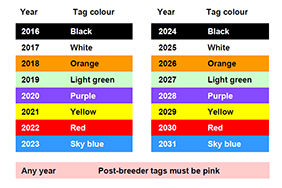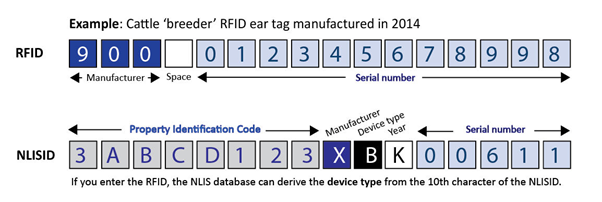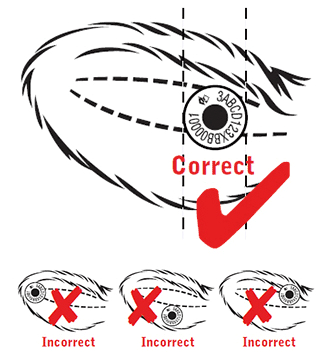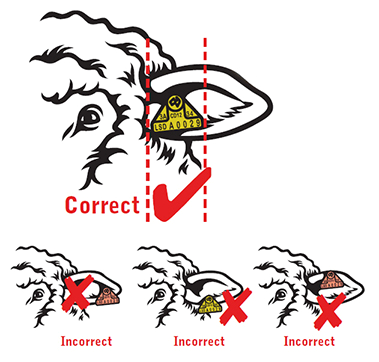
Cattle breeder devices
Cattle breeder devices are always white. Here are some examples of cattle breeder devices.
Animal Identification
All animals leaving a property (PIC) must be identified with an NLIS approved device before moving unless there is a specific exemption or a permit is obtained from the state or territory authority
Identification requirements for cattle
The NLIS approved cattle identification list is available here NLIS Approved Identification for Cattle.
NLIS approved devices for cattle must be electronic (RFID). This can be either a single ear tag, or a rumen bolus/visual ear tag combination.
All cattle must be identified with an NLIS approved identification device before being moved off a property. Find out more about the requirements here: NLIS AIT
Requirements.
Identification requirements for sheep and goats
From 1 January 2025 it will be mandatory for all sheep and managed goats born to be tagged with an NLIS-approved species-specific electronic identification (eID) device before moving off a property.
For a list of NLIS-approved eID devices for sheep and goats and manufacturer contact details please refer to this guide.
This list includes the details of NLIS-approved tags, including visual tags, for sheep and goats.
For information specific to your state or territory about the national rollout of sheep and goat identification, please refer to this webpage.
For help resources to get prepared for sheep and goat eID, please refer to ISC’s dedicated Sheep & Goat eID webpage.
To find out more about the NLIS Animal Identification Technology requirements, please refer to this document: NLIS AIT Requirements.
Applicators and scanners
ISC approves the applicator in conjunction with the animal identification but does not approve equipment such as readers or scanners. All electronic animal identification containing a RFID must be readable by commercially available handheld and panel readers which operate within the bandwidths defined in AS5019-2001.
Sheep and goats can only be identified with an NLIS-approved device before being moved off a PIC.
From 1 January 2025, all sheep and managed goats nationally will be required to have an NLIS-approved electronic identification (eID) device applied before leaving a property.
eID devices have been used on sheep and goats in Victoria since 2017.
Some tagging exemptions are in place for Harvested Rangeland Goats and dairy goats in some states and territories.
Check with your state/territory NLIS authority for more information.
Post-breeder devices must be applied to sheep or goats that are being moved off a property which was not their property of birth.
Refer to your movement documentation (e.g. NVD) for details.
For more information about NLIS accredited sheep and goat devices, see our Accredited Devices List for Sheep and Goats.


If you need to purchase NLIS tags/devices you firstly need a PIC from your state or territory department of agriculture. If located in QLD contact QLD DAF to obtain authorisation to order NLIS tags. If located in Victoria, contact Agriculture Victoria to order NLIS tags. For all other states and territories you can order NLIS tags online or via resellers.

If you are moving an animal off its PIC of birth, tag the animal with an NLIS-accredited breeder device. Once an animal has been tagged, the tag should remain with the animal for life.
It is an offence to remove an NLIS tag from an animal and apply another tag. If an animal has lost a tag and is no longer on its PIC of birth, tag the animal with an NLIS-accredited post-breeder device.
Tagging exemptions are in place for harvested (feral) and dairy goats in some states. Contact your NLIS state/territory authority for more information.
All devices that are NLIS accredited will have the NLIS logo printed on them. Cattle devices will also have the words 'Do not remove' printed on the male button. For more information about NLIS tags, devices and tag manufacturers, see our Accredited Devices Lists for Cattle and Sheep and Goats.
If you're receiving warning emails, having issues with the NLIS database or are having trouble logging in, check out the support information available.

An electronic Radio Frequency Identification Device (RFID) has both an NLISID and an RFID number. Both numbers can be used to individually identify animals on your property. When you buy NLIS devices for your PIC, the device manufacturer registers the NLISID and RFID numbers on the database, so when you use the database, you can enter either the NLISID or the RFID associated with a specific animal.
An NLISID number is printed on the outside of an electronic ear tag, or on a visual ear tag indicating a rumen bolus was applied (cattle only). An NLISID number can only be read visually by looking at the number on the device on a tagged animal. The first eight characters of an NLISID are the PIC the device was issued to (see example below).
An RFID number is assigned to the electronic RFID chip inside a device. An RFID number can only be read electronically, when animals are scanned with a tag reader.


Livestock should be tagged so that the tag is applied in the middle of the animal's ear, in accordance with the tag manufacturer's instructions.
A correctly applied cattle tag should be applied to the animal's right ear, as shown below:

A correctly applied sheep tag should usually be applied to the animal's left ear, as shown below. Please refer to your state/territory NLIS authority for any other specific requirements.

All animals leaving a property (PIC) must be identified with an NLIS accredited device before moving unless a permit is obtained from the state or territory authority. More information on tagging requirements for cattle, sheep and goats is available on the ISC website.
You do not need to notify NLIS when you tag an animal on your property. The NLIS database does not distinguish between tags applied to your animals and tags that are still unused. All devices are automatically registered to your PIC by the tag manufacturer when they are issued to you.
It can be useful to keep your own records of what tags are used, when and in what animals. ISC recommends keeping a record of the tag numbers when purchased and to which animals they have been applied. Visual ID numbers are printed on the bag for easy recording.
For an RFID tag to obtain full NLIS accreditation, it must complete a three-year field trial on several different properties across Australia and demonstrate loss rates across all trial properties below 3.5%.
If any producer is experiencing high tag loss rates then you are urged to contact the tag manufacturer directly and notify them of the problem. If you are unhappy with the manufacturer’s response to their problem, then a complaint can be lodged with ISC and we will further investigate the matter.
Complaints can be submitted via this NLIS Device Complaint Form or by phoning the ISC Helpdesk on 1800 683 111.
You can use either visual NLIS ID numbers or electronic RFID numbers to record a livestock movement.
Livestock movements with electronic tags – or RFID tags – should be recorded using the Livestock moved onto/off my property function. Access ISC's NLIS how-to guide for moving livestock onto or off a PIC (type in details) or how-to guide to moving livestock onto or off a PIC (file upload) for assistance with this.
Livestock movements with visual tags should be recorded using the mob-based movement onto/off my property function. Access ISC's NLIS how-to guide for moving mobs onto or off a PIC (type in details) or how to guide to moving mobs onto or off a PIC (file upload) for assistance with this.
For information regarding the tagging of EU cattle, please contact European Union Cattle Accreditation Scheme on 1800 305 544 (available Monday to Friday 8am to 4pm) for more information.
For more information on pig tags for NLIS, visit pigpass.australianpork.com.au/faq and then look for the identification tab.
Electronic tags will need to be read manually or by using a scanner or a wand. If you don’t have one, you can ask to hire or borrow one from an agent.
If you’re having difficulty reading an animal’s tag number and it is electronically tagged, use a wand or employ an agent to assist. You may also be able to put the animal into a crush if there is one available to assist you in reading the tag.
Alternatively, the previous owner of the animal may have a record of the animal’s tag number. If you can at least obtain the unique last five digits of the animal’s tag number and have the previous owner’s PIC, the ISC Helpdesk may be able to help you work out the animal's full tag number using this information.